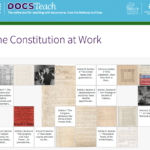What is the nomination process for Supreme Court justices and federal judges? Find out in a multimedia package of educational resources geared to high school students, their teachers, and interested adults. What do judges promise in the judicial oath of office? What is the role of justices and judges? What kinds of information are nominees asked to share during the nomination process? What do judges, themselves, say about what it means to be impartial?
3 Must-Have Supreme Court Nomination Documents
“3 Must-Have Supreme Court Nomination Documents” looks at President Ronald Reagan’s appointment of Supreme Court Justice Antonin Scalia in 1986. Primary Source A outlines the suggested qualities of an ideal candidate for President Reagan to nominate to the Supreme Court. Primary Source B provides a Memo to the President from Peter J.
Wallison, Counsel to the President, in which Wallison provides background information with a few potential questions for both Justice Rehnquist and Judge Scalia. Primary Source C is a transcript from President Reagan’s August 9, 1986, Radio Talk on the appointment of the Supreme Court Justices. Each of these documents showcase the amount of thought and consideration the president must take when nominating a Supreme Court Justice.
2017 Supreme Court Nomination: Advising Senators Activity
Are you teaching about President Trump’s nomination of Judge Neil Gorsuch to the U.S. Supreme Court? Lead your students through an exploration of the process and have them take on a role as adviser to a senator in preparation for the Senate Judiciary Committee’s confirmation hearing.
Judicial Appointments under the United States Constitution
Explore historical sources related to judicial appointments under the United States Constitution. A great resource to use during Supreme Court nomination debates to illustrate the original conflicts over the court and contextualize contemporary issues.
The Appointment of Sandra Day O’Connor
The U.S. Constitution grants the President the power to appoint people to a variety of government positions. These appointments require careful thought and consideration since the people can have a great impact on the lives of many Americans during that President’s term. Some appointments need even greater thought and consideration, and those are to the federal judicial system and more importantly, to the Supreme Court of the United States. Justices of the Supreme Court (and other federal courts) serve lifetime appointments. Their rulings as they interpret the Constitution, and other situations as outlined in Article III of the Constitution, can have far-reaching effects for generations. With this awesome power to appoint comes an equally awesome responsibility to make sure that the individuals are the best people for the job. In this lesson, students will examine the appointment of Supreme Court Justice Sandra Day O’Connor, who was also the first female Justice. Students will examine the process by which a President makes the selection and the steps that lead to that person being confirmed by the Senate (or not).
Primaries: By Invitation Only?
Primary season can be a wild ride. Voters narrow the field of candidates in contest after contest, while the parties use complicated rules to try to control who ultimately secures the nomination.
The Constitution at Work
Judicial Nominations
Conversation starter using a political cartoon, which compares the public’s interest in judicial nominations with contestants on the television show “American Idol.”
